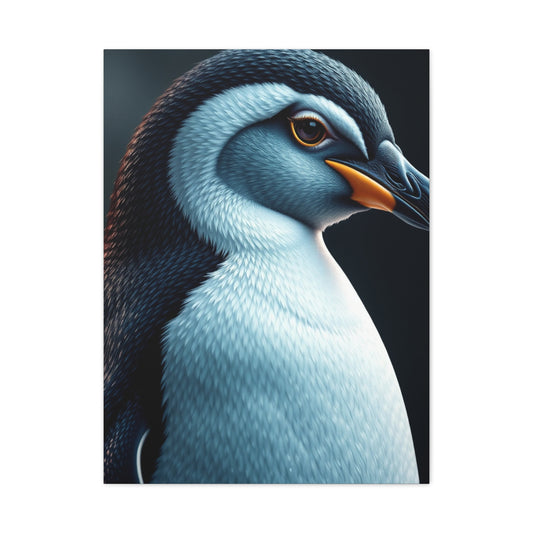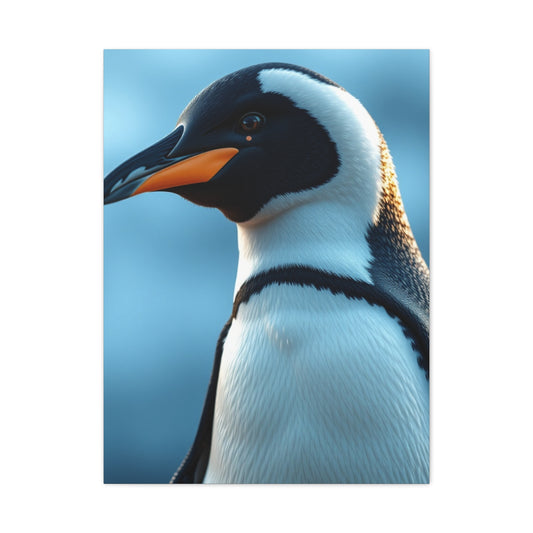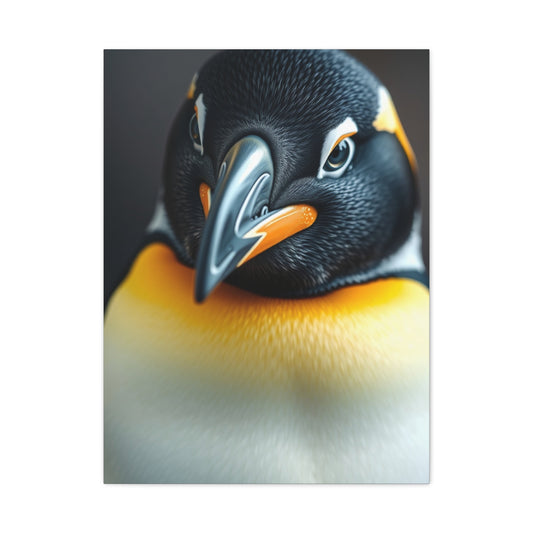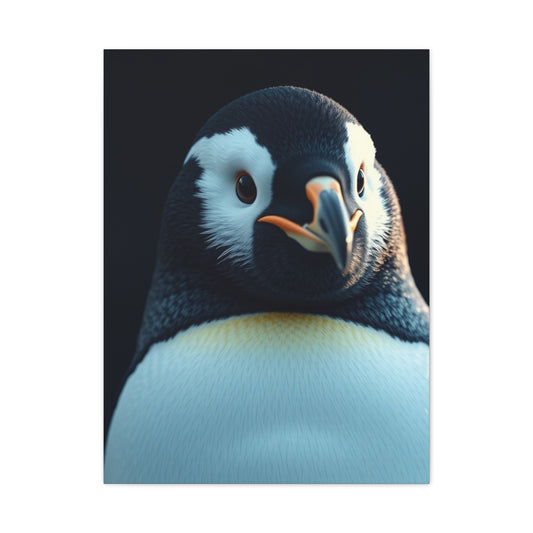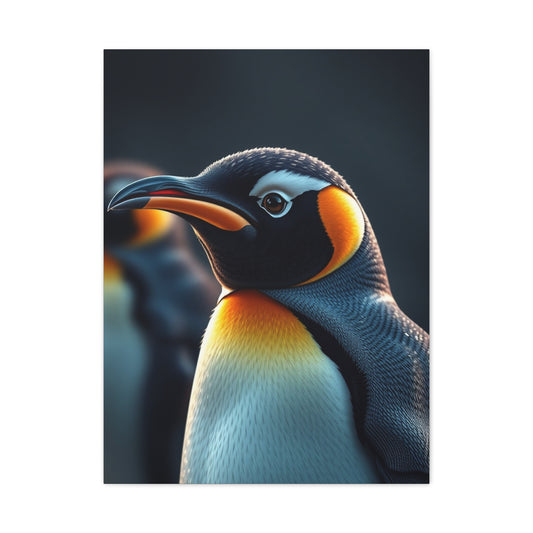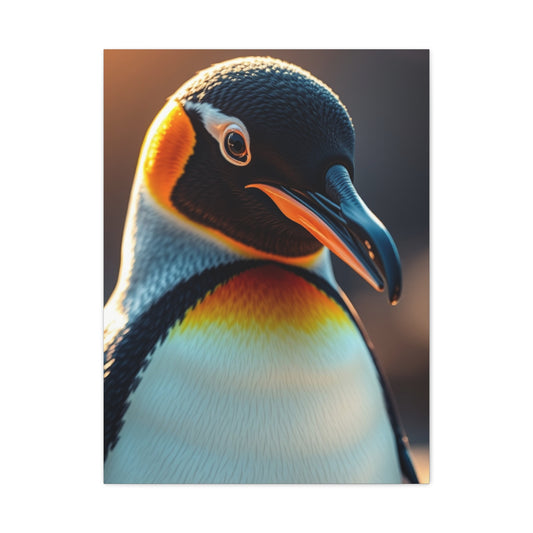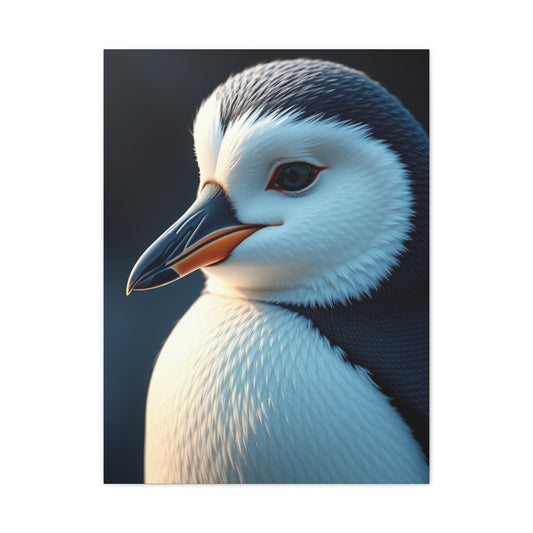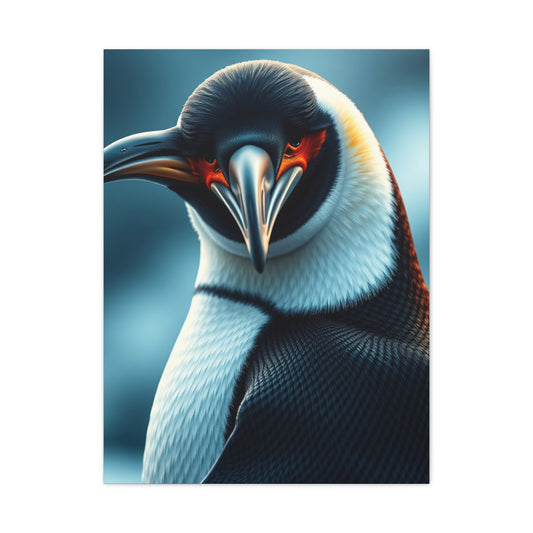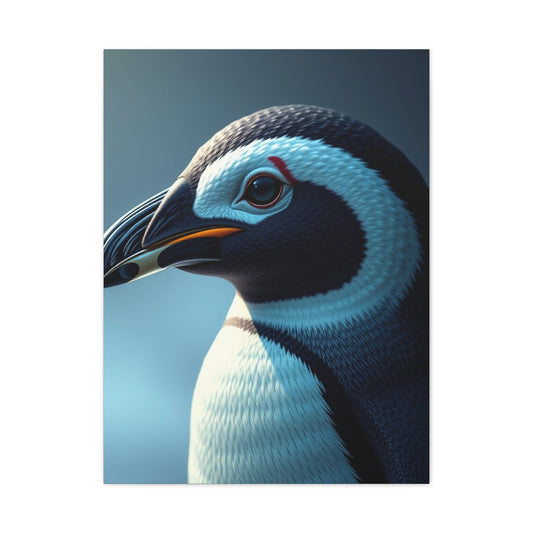Transform Your Space with Penguin Wall Art in Just 1 Minute
Creating a living space that reflects your affection for animals can be both whimsical and comforting, and few creatures capture the imagination quite like penguins. These charismatic birds evoke feelings of playfulness, companionship, and resilience, making them ideal muses for a cozy room design. While limited square footage may seem like a constraint, thoughtful planning can transform even the smallest area into a sanctuary that marries style, functionality, and personality. Integrating penguin-inspired elements into your room not only brings warmth but also creates an inviting environment where each design choice tells a story. Through clever use of color, decor, and furnishings, you can craft a space that is at once visually engaging and practically efficient, all while celebrating your love for these enchanting animals.
Historical Background
Penguins have long captured human imagination, inspiring fascination, admiration, and creative expression across cultures. Their presence in art, literature, and folklore spans centuries, reflecting the ways humans have observed and interpreted these remarkable birds. Early explorers of Antarctica, encountering penguins in their natural habitats, documented their behaviors in detailed journals and sketches. These observations highlighted not only the penguins’ striking appearance but also their social behaviors, cooperative hunting techniques, and adaptability to extreme climates. Such early accounts contributed to the perception of penguins as symbols of resilience, community, and endurance—qualities that resonate strongly in contemporary creative interpretations, including interior design.
As exploration expanded and penguins entered popular imagination, they began appearing in children’s literature, cartoons, and illustrations. From anthropomorphized characters in storybooks to scientifically accurate depictions in educational texts, these birds offered both charm and inspiration. Their distinctive black-and-white plumage and playful waddling movements captured the imagination of illustrators and artists alike, leading to their incorporation into paintings, sculptures, and decorative arts. In particular, mid-20th-century design saw penguin motifs used in home accessories, ceramics, and even textiles, reflecting a growing appreciation for these animals as sources of aesthetic inspiration.
In modern media, penguins have continued to hold a special place, appearing in documentaries, animated films, and online content that emphasizes their endearing personalities and social dynamics. They are often portrayed as symbols of loyalty, cooperation, and resilience—qualities that resonate with human audiences and offer a narrative foundation for thematic design. By integrating penguin motifs into interior spaces, homeowners can draw upon this rich historical and cultural narrative, connecting contemporary decor with centuries of fascination and artistic interpretation.
Penguins also hold symbolic significance in various cultural contexts. In some traditions, they represent adaptability and endurance due to their ability to thrive in harsh environments, while in others, they are associated with family bonds and nurturing behaviors, reflecting their communal parenting strategies. This symbolism can inform design choices, allowing a space to convey subtle narratives of resilience, companionship, and joy. For example, a wall art series featuring penguins in social clusters can echo the importance of family and collaboration, while abstract representations in monochromatic tones might emphasize adaptability and elegance. By weaving historical context, cultural symbolism, and contemporary aesthetics together, a penguin-inspired interior becomes more than decorative—it becomes an homage to nature, culture, and human creativity, enriching the emotional and intellectual experience of the room’s occupants.
Understanding the historical backdrop also offers guidance in choosing materials, textures, and artistic styles. Traditional representations often employed ceramics, wood carving, or oil paintings, emphasizing craftsmanship and materiality. Contemporary interpretations embrace digital art, mixed media, and minimalist silhouettes, highlighting innovation while maintaining the thematic essence. By referencing both historical and modern expressions of penguins, designers can craft spaces that feel layered, sophisticated, and resonant, connecting the past to present-day aesthetic sensibilities.
Furthermore, penguins’ global presence—ranging from Antarctic colonies to temperate islands—underscores their versatility as a design motif. Different species provide diverse visual cues: the elegant black-and-white contrasts of Emperor penguins, the playful, diminutive forms of Little Blue penguins, or the striking yellow accents of Macaroni penguins. Integrating these species into wall art, decor, or textile patterns adds variety and subtle sophistication, allowing the room to feel dynamic without becoming visually chaotic. By drawing inspiration from both natural history and artistic representation, the space communicates a narrative that is informed, engaging, and deeply connected to the enduring fascination humans have held for these creatures.
Core Concepts and Foundations
Designing a penguin-themed room requires a foundation built on principles of cohesion, functionality, and narrative continuity. At the heart of this approach is the concept of balance: each element, from furniture to wall art, should reinforce the motif while maintaining spatial harmony. One of the most fundamental aspects of design is color selection. Penguins’ natural coloration—black, white, and subtle grays—provides a versatile palette that is both serene and striking. Using these tones as the base for walls, furniture, and textiles establishes a cohesive backdrop, while strategic touches of icy blue, soft yellow, or muted turquoise can add visual interest, depth, and a sense of environmental context. These accent colors can reference elements such as water, ice, or sunlight, subtly enriching the narrative of the penguin motif.
Beyond color, texture plays a critical role in reinforcing thematic cohesion. Smooth surfaces can evoke the sleekness of penguin feathers, while plush fabrics, layered rugs, or tactile wall treatments introduce warmth and comfort. Contrasting textures help maintain visual engagement and prevent monochrome tones from feeling flat. For instance, pairing a polished, minimalist coffee table with a thick wool rug and a collection of soft, penguin-themed pillows creates an interplay between refinement and coziness. Similarly, textured wall art—such as layered canvases, relief sculptures, or fabric-mounted prints—can provide dimensionality that mirrors the birds’ natural environment, allowing the motif to extend beyond mere imagery into spatial experience.
Functional considerations are equally important, particularly in smaller rooms. Multi-functional furniture allows thematic decor to remain visible while maximizing utility. Storage ottomans, shelving units with integrated display areas, and foldable seating options enable occupants to maintain order without sacrificing visual appeal. By blending function with aesthetic intention, the room remains practical for everyday living while fully embracing the penguin motif. For example, a floating shelf can simultaneously showcase framed penguin wall art, small figurines, and books, preserving floor space while contributing to the narrative of social cohesion, an attribute often associated with penguin colonies.
Another foundational concept is the deliberate placement of visual focal points. Wall art serves as the primary narrative anchor, guiding viewers’ attention and establishing thematic continuity. Large framed prints or canvas pieces can function as the centerpiece, while smaller decorative items—figurines, accent pillows, or subtle patterns—support the overall motif without overwhelming the space. Arrangement should consider scale, proportion, and visual flow. Grouping items in asymmetrical clusters or along a narrative sequence can create movement, directing the eye naturally from one element to another and reinforcing the story of the penguin motif throughout the room.
Lighting is another essential aspect of foundational design. Adequate illumination not only enhances visibility but also accentuates textures, colors, and wall art. Natural light can amplify the crisp contrasts of black-and-white decor, while warm artificial lighting can soften the ambiance and highlight textural elements. Reflective surfaces such as mirrors, metallic accents, or glossy finishes further enhance the perception of space, creating a sense of openness that complements the serene yet playful nature of penguin-inspired decor. Layered lighting solutions, including overhead, task, and accent lighting, allow for versatility in mood and highlight specific features of the design, particularly wall art and sculptural elements.
Integration of personal touches is a final foundational element. Incorporating custom or DIY pieces, souvenirs, or family photographs alongside penguin-themed wall art can create a deeply personal space that tells a story unique to the inhabitant. Personalization strengthens the narrative quality of the room, making it more than a visually appealing environment—it becomes a curated sanctuary that reflects individual passion, creativity, and connection to the motif. For example, a handmade mobile featuring penguin silhouettes can hang above a reading nook, blending functionality with thematic expression while adding movement and whimsy.
Ultimately, the core principles of a penguin-themed room revolve around harmony, coherence, and intentionality. By thoughtfully integrating color, texture, lighting, furniture, and personal elements, the space achieves a balance between visual intrigue and functional comfort. Each design decision, from the choice of wall art to the arrangement of accent pieces, contributes to an immersive environment where the penguin motif resonates organically. This foundational approach ensures that the room is not only aesthetically compelling but also emotionally engaging, reflecting both the natural beauty of these creatures and the inhabitant’s appreciation for their charm, adaptability, and social grace.
The interplay between historical inspiration and foundational design principles allows a penguin-themed interior to transcend decoration, becoming a multi-dimensional experience. The room communicates a narrative rooted in nature, culture, and personal expression, creating an environment that feels curated, thoughtful, and alive. By balancing visual appeal with practical utility and by layering textures, colors, and thematic elements, the space embodies both elegance and playfulness, honoring the enduring fascination humans have held for penguins across centuries.
Types and Categories
Incorporating penguin inspiration into your room can take multiple forms, from overt thematic elements to subtle, nuanced touches. Wall art provides a versatile canvas, ranging from playful illustrations and photographic prints to abstract interpretations that evoke the penguin aesthetic. Plush toys or decorative pillows offer tactile engagement and can serve as endearing focal points or accents, particularly in cozy corners or seating areas. Sculptures and figurines add three-dimensional interest, capturing movement and personality in miniature form. Beyond decor, functional pieces such as furniture and lighting can be adapted to echo the theme through shape, texture, or color. Consider layered elements that combine utility with visual appeal, ensuring that every item, whether large or small, contributes to the overarching motif while maintaining spatial efficiency.
Practical Applications
Bringing a penguin-inspired vision to life involves careful consideration of color, decor, furniture, storage, lighting, and personal touches.
Color Palette Inspired by Penguins
A deliberate color scheme sets the stage for an animal-themed room. Embrace the natural palette of penguins by blending crisp whites, charcoal blacks, and gentle grays to establish a serene and cohesive base. Introduce subtle hints of icy blue to conjure the Antarctic environment or soft yellow accents that reflect the playful character of these birds. Apply these shades across walls, textiles, and accessories to ensure a unified aesthetic. Layering tonal variations adds dimension, preventing the space from feeling flat or monotonous, and allows the penguin theme to permeate subtly without dominating every visual surface.
Penguin-Themed Wall Art and Decor Items
Wall art forms the centerpiece of any animal-inspired interior, providing a visual narrative that anchors the space. Opt for framed prints or canvases that depict penguins in their natural habitat, engaging in playful behaviors, or rendered in artistic abstraction. Sculptural pieces or whimsical wall-mounted figures can offer dynamic focal points that draw the eye and spark conversation. Complement wall art with plush toys, decorative pillows, or accent pieces that echo the theme, but exercise restraint to avoid clutter. Carefully curated selections transform your room into a lively yet orderly environment, allowing each penguin-inspired element to shine individually while contributing to a cohesive whole.
Multi-Functional Furniture
Maximizing utility is paramount in compact spaces. Select furniture that serves multiple purposes, such as storage ottomans, foldable desks, or coffee tables with hidden compartments. These pieces preserve floor space while providing surfaces for displaying penguin-themed decor or practical items. Modular seating and stackable units allow flexibility for various activities, from relaxation to entertaining, without compromising thematic integrity. The interplay of form and function ensures that the room remains both stylish and livable, highlighting your penguin-inspired aesthetic without sacrificing everyday usability.
Clever Storage Solutions
Vertical space and concealed storage strategies help maintain an organized and visually appealing environment. Floating shelves can display penguin-themed books, wall art, or figurines while freeing up floor space. Built-in cabinets, recessed niches, and wall-mounted organizers blend seamlessly with room architecture, offering ample storage while contributing to the overall aesthetic. Thoughtful arrangement and layering of items prevent overcrowding, allowing the penguin motifs to be appreciated fully. Efficient storage transforms even the smallest area into a sanctuary of style and order, reinforcing the sense of openness and tranquility.
Natural Light and Airflow
A bright, airy room enhances both mood and perceived space. Penguins are creatures of the outdoors, and incorporating abundant natural light mirrors their expansive habitats. Sheer curtains or translucent blinds filter sunlight gently, maintaining privacy without sacrificing luminosity. Position mirrors strategically to reflect light and create an illusion of depth, further enlarging the room visually. Adequate ventilation and unobstructed airflow keep the environment fresh, inviting, and conducive to both relaxation and creativity. In essence, light and air become integral components of the design, complementing the penguin theme while elevating comfort.
Personal Touches
Personalization is the final, defining layer of a themed room. Integrate mementos such as photographs from wildlife excursions, DIY projects featuring penguin motifs, or hand-crafted accessories to imbue the space with individuality. Custom artwork or commissioned pieces allow you to express your unique interpretation of penguins, blending artistry with affection. Subtle elements like patterned throws, themed stationery, or decorative vignettes create a lived-in, intimate atmosphere that reflects your personality and passion. These thoughtful touches ensure the room is not merely decorative but an authentic reflection of your relationship with these beloved animals.
This approach creates a harmonious, penguin-inspired environment where every design decision is intentional, enhancing both aesthetic appeal and functionality. From a curated color palette to artful wall displays, multi-purpose furnishings, and personalized accents, each element contributes to a small-space sanctuary that celebrates the charm and character of penguins. By integrating these principles, you can transform any room into a cozy, stylish retreat that radiates personality, warmth, and an enduring love for animals.
Techniques and Methods
Bringing a penguin-inspired theme to life in a living space requires more than just selecting motifs; it involves a thoughtful interplay of techniques that harmonize aesthetics and functionality. One fundamental approach is layering textures and materials to evoke depth and tactile richness. Soft textiles like plush throws or velvety cushions can simulate the tactile comfort associated with penguins’ downy feathers, while sleek surfaces in monochromatic shades mirror the birds’ distinctive plumage. Wall art, particularly framed prints or abstract representations, can be positioned strategically to create focal points that anchor the room. Consider grouping pieces at varying heights to generate visual rhythm, or integrating shadow boxes and three-dimensional sculptures to infuse a sense of dynamism.
Lighting techniques play a pivotal role in enhancing the penguin motif. Natural illumination is ideal, but layered artificial lighting can accentuate decor elements in a nuanced manner. Warm, diffused lights can highlight textured wall art, while directional spotlights can bring attention to sculptural pieces or thematic arrangements. Reflective surfaces like mirrors or metallic accents can bounce light throughout the space, expanding perception and creating the illusion of additional depth. Strategic use of color, texture, and lighting ensures that the penguin-inspired theme is immersive, cohesive, and adaptable across different areas of the room.
In addition, the careful selection of multi-functional furniture can serve both aesthetic and practical purposes. Modular units that accommodate seating, storage, or display allow for efficient space management without compromising thematic integrity. Open shelving, for instance, can host penguin figurines, small plants, or themed books, providing both function and visual interest. Layering these elements thoughtfully and balancing them with negative space prevents the decor from appearing cluttered, particularly in smaller rooms. Combining techniques from interior design, art curation, and spatial optimization creates an environment where the penguin motif thrives, becoming more than just a decorative element but a cohesive narrative throughout the space.
Challenges and Common Mistakes
While designing a penguin-themed space can be enchanting, several challenges can arise that may compromise both aesthetics and functionality. One common pitfall is over-saturation of the theme, where every item, color, or pattern references penguins, resulting in visual fatigue. Achieving balance requires selective curation: a few standout pieces should dominate while secondary accents subtly support the motif. Overly literal representations, such as excessive cartoonish imagery, can overshadow the elegance of a space, so careful consideration of scale, proportion, and style is essential.
Spatial constraints present another frequent challenge, especially in compact living areas. Without multi-functional furniture or clever storage solutions, themed decor can quickly overwhelm the room. Floating shelves, built-in cabinetry, or modular seating units are practical remedies that maintain open circulation while allowing thematic displays. Failing to optimize vertical space or ignoring light sources can create a cramped, shadowy environment that diminishes both the visual impact and the cozy atmosphere associated with penguin motifs.
Color imbalances are a subtler but significant risk. While black and white serve as foundational shades, improper use of accent colors can disrupt cohesion. Icy blues, gentle yellows, or muted grays should be employed sparingly to provide depth and interest rather than dominate the palette. Additionally, neglecting the interplay between textures and materials can render a room visually flat; smooth, reflective surfaces may need contrast from plush or matte elements to achieve equilibrium. Understanding these challenges and consciously addressing them prevents common design missteps, resulting in a space that is immersive, balanced, and aesthetically satisfying.
Trends and Future Outlook
Animal-inspired interiors, particularly those influenced by penguin motifs, continue to evolve in response to broader design trends. Minimalist yet expressive environments are gaining popularity, where carefully curated pieces replace clutter and thematic representation becomes subtle and refined. Wall art is increasingly favored over standalone figurines, with abstract or stylized depictions of penguins providing artistic flair without overwhelming the room. Mixed-media installations, incorporating digital prints, acrylics, and textural elements, allow designers to explore nuanced interpretations of animal forms while maintaining spatial harmony.
Sustainability is also shaping the future of themed interiors. Eco-conscious consumers prefer materials such as reclaimed wood, recycled textiles, or low-impact paints, aligning the decor with ethical and environmental principles. Modular furniture made from sustainable sources ensures that functionality and environmental responsibility coexist, providing practical solutions for small spaces without compromising aesthetic appeal. The integration of technology, such as smart lighting or climate-responsive systems, allows rooms to adapt dynamically, enhancing comfort while highlighting thematic elements like wall art or decorative accents.
Additionally, the incorporation of personalized experiences is expected to gain prominence. Curated displays that reflect personal encounters with wildlife, custom-commissioned penguin artwork, or interactive design features can transform a room into an experiential space rather than a static showcase. As design philosophy shifts toward creating emotionally resonant and environmentally mindful interiors, penguin-inspired decor offers an opportunity to blend charm, functionality, and sustainability in ways that feel fresh and forward-thinking.
Expert Insights
Interior designers and artists who specialize in animal-themed spaces emphasize the importance of thoughtful curation and subtlety. According to experts, successful penguin-inspired rooms are not defined by the quantity of motifs but by strategic placement and material interplay. They advise starting with a foundational color scheme that echoes natural penguin habitats, then introducing layered textures and wall art as accent elements. Incorporating multi-functional furniture, clever storage solutions, and reflective surfaces are recommended techniques to amplify space while maintaining aesthetic cohesion.
Art curators highlight the power of wall art in creating thematic continuity. A single large-scale print or a curated gallery wall can serve as the central narrative, while smaller, tactile elements like sculptures or decorative pillows provide dimensional interest. The emphasis is on achieving visual rhythm through variation in scale, placement, and material, ensuring that the theme is engaging without becoming monotonous. Lighting experts further stress the importance of integrating both natural and artificial sources to highlight textures, emphasize wall art, and create an inviting atmosphere.
Behavioral insights suggest that environments reflecting personal passions, such as penguin motifs, can enhance mood, reduce stress, and encourage creativity. Thoughtfully designed animal-themed rooms, particularly those balancing aesthetic elegance with functionality, provide both comfort and inspiration. Expert consensus is that attention to detail, sensitivity to spatial dynamics, and integration of personal elements are critical to crafting a room that resonates emotionally while remaining visually compelling.
In conclusion, the techniques, challenges, trends, and expert insights surrounding penguin-inspired interiors illustrate a multifaceted approach to design. From layered textures and curated wall art to sustainable materials and strategic lighting, every decision contributes to a cohesive narrative. Recognizing common mistakes and embracing evolving trends ensures that the room remains both functional and enchanting. By combining artistic sensibility, practical ingenuity, and personal expression, a penguin-themed space can transform from a mere decorative concept into a lively, immersive, and enduring sanctuary.
Seasonal Variations and Adaptations
Transforming a penguin-inspired room over the course of the year allows for both visual freshness and an ongoing connection to the motif. Seasonal changes can be subtly reflected in decor items, textiles, and wall art, creating a dynamic environment that evolves with the months. During winter, deeper grays, icy blues, and soft whites can mimic polar landscapes, while plush fabrics and layered textures enhance warmth and comfort. Wall art featuring snow-laden scenes or abstract representations of Antarctic expanses can reinforce the seasonal ambience without overwhelming the room. Consider incorporating reflective elements such as glass or metallic frames for wall art, as these can catch winter sunlight or artificial light to create a frosty, crystalline effect, echoing the icy habitats of penguins. Layered rugs and faux-fur throws can provide tactile warmth, inviting occupants to linger in cozy corners.
Spring invites lighter textures and pastel accents that complement the foundational black-and-white palette, bringing a sense of renewal and vitality. Penguin-themed decorative pillows or small figurines placed strategically on shelves or tables can highlight the playful and social nature of these creatures, mirroring the season’s energy. Consider introducing floral patterns, subtle greenery, or botanical motifs that complement penguin wall art. A small tabletop terrarium with moss or air plants can harmonize with the seasonal theme, offering a living element that contrasts the crispness of monochrome tones. Wall art can incorporate hints of dawn or sunrise colors, reflecting the season’s freshness while maintaining thematic cohesion with the penguin motif.
Summer allows for brighter, airy additions such as sheer curtains and reflective surfaces that amplify natural light, giving the space a breezy and expansive feel. Wall art can shift toward aquatic or oceanic motifs, subtly referencing the penguin’s natural environment while keeping the theme cohesive. Consider positioning art near windows to allow sunlight to interact with textures or metallic details, creating a shimmering effect reminiscent of sunlit ice or glistening water. Lightweight furniture and open shelving arrangements allow airflow and enhance a sense of openness, preventing the space from feeling heavy despite seasonal layering. Nautical-inspired decorative accents, such as shells, driftwood, or ocean-colored ceramics, can enrich the penguin theme without detracting from its focus, evoking the birds’ coastal habitats.
Autumnal adaptations focus on warmth and tactile comfort. Richer grays, muted yellows, or soft browns can be integrated through throws, cushions, or rugs, complementing penguin-inspired decorative elements. Rotating wall art to feature earthy tones or seasonal textures provides visual variation while maintaining thematic continuity. Wooden frames, woven textures, and natural fibers can anchor the room with an organic touch, evoking the transitional nature of autumn. Layering textures becomes particularly important, combining smooth surfaces with knitted or embroidered materials to engage touch as well as sight. Small seasonal arrangements, like pinecones in decorative bowls or autumnal garlands near penguin wall art, offer subtle cues that celebrate the passage of time while harmonizing with the motif. By embracing seasonal adjustments, the room remains engaging throughout the year, offering both aesthetic novelty and emotional resonance.
A more advanced approach to seasonal adaptation includes rotating larger decor pieces or wall art, creating thematic zones that correspond with specific months or holidays. For instance, winter months could feature a larger canvas depicting Antarctic wildlife, while summer might showcase penguins near glacial waters or playful young chicks. This rotation not only sustains visual interest but also fosters a deeper connection between the inhabitant and the natural world, allowing the room to tell an evolving story rather than remaining static.
Advanced Wall Art Techniques
Wall art serves as the cornerstone of any penguin-themed interior, offering a versatile medium through which creativity, personality, and spatial dynamics converge. Beyond simple prints or photographs, innovative techniques allow for immersive, multi-dimensional displays. Mixed-media installations, combining painted canvases, textured surfaces, and three-dimensional sculptural elements, create visual intrigue and depth. Layering translucent materials or incorporating subtle metallic accents can simulate light reflections, enhancing the interplay between wall art and ambient lighting. Consider integrating resin or acrylic overlays that give the impression of ice or water, deepening the environmental narrative of penguins’ natural habitats.
Abstract interpretations of penguins are increasingly popular, providing a sophisticated alternative to literal representations. Stylized forms, fragmented compositions, or minimalistic silhouettes capture the essence of the motif while allowing flexibility in color and scale. For example, a series of small monochromatic canvases can collectively suggest the shape and movement of penguins without relying on realistic imagery, offering a contemporary, gallery-like aesthetic. Wall-mounted sculptures or relief pieces can be arranged in clusters or sequences, guiding the eye through the space and creating a narrative flow that complements other decorative elements. These approaches transform wall art from static decoration into a dynamic focal point that interacts with furniture, textiles, and natural light.
Digital wall art is another evolving avenue, with high-resolution prints or backlit panels offering vibrant colors and fine details that bring penguin-inspired imagery to life. Incorporating modular frames or adjustable mounting systems allows for easy rotation of artwork, facilitating seasonal updates or thematic experimentation. Projection art is an emerging trend, where subtle animated penguin motifs or abstract environmental textures can be projected onto walls or ceilings, creating an immersive atmosphere that changes with time or lighting conditions. By blending traditional techniques with contemporary innovations, wall art becomes both an aesthetic anchor and a medium of ongoing creative exploration.
Wall art can also function as a storytelling device. Consider a chronological arrangement of images depicting penguins’ life stages or migratory patterns, subtly educating viewers while enhancing aesthetic appeal. Using unconventional materials, such as fabric collages, recycled metals, or layered paper, introduces tactile variety and sustainability to the room, merging artistic expression with environmental consciousness. Lighting is integral to maximizing the impact of these techniques; strategic spotlighting, backlighting, or reflective surfaces can amplify textures, shadow play, and depth perception, transforming even small wall segments into captivating visual narratives.
Interactive and Experiential Decor
An emerging trend in animal-inspired interiors involves interactive and experiential elements that engage more than the visual senses. Incorporating tactile textures, kinetic displays, or modular components allows inhabitants to actively interact with the room, deepening the connection to the penguin motif. Textured wall panels, layered fabrics, or sculptural elements invite touch, while adjustable lighting and reflective surfaces alter perception and mood throughout the day. Interactive shelving or furniture units, which double as display areas for penguin-themed decor, encourage hands-on engagement and flexible arrangement.
Small DIY projects, such as creating custom figurines or painting accent pieces, add a personal dimension that transforms the room into a creative sanctuary. For instance, inhabitants can design miniature icebergs for penguin figurines or craft felted penguin motifs that hang from shelves or walls. Rotating these items seasonally or periodically rearranging their placement sustains novelty and deepens the emotional bond with the theme. Even subtle auditory elements, like gentle soundscapes evocative of Antarctic winds or ocean waves, can heighten immersion, creating an environment that resonates on multiple sensory levels.
Experiential decor can extend beyond sensory stimulation to encourage social interaction or engagement. For example, a small corner could be dedicated as an interactive penguin observation station, featuring books, tactile maps, or a digital display of penguin habitats. This area can serve as an educational and recreational focal point, blending thematic consistency with practical utility. Furniture with modular components allows inhabitants to modify the room’s layout for different activities, whether hosting guests, creating a study space, or arranging a cozy reading nook surrounded by penguin-themed decor.
Textural layering is also a vital component of experiential design. Combining smooth surfaces, woven fabrics, and soft plush materials ensures that touch complements visual engagement. Interactive wall panels or relief art pieces can feature raised silhouettes, cutouts, or movable components, providing playful and tactile stimulation that deepens the room’s immersive quality. Even subtle scent elements, such as natural wood, clean linens, or oceanic-themed aromas, can complement the penguin motif, creating a fully multisensory experience.
By emphasizing interaction, experimentation, and personal expression, the penguin-inspired room becomes a dynamic space where inhabitants actively shape and engage with their environment. Every element, from wall art to furniture and textiles, contributes to a living narrative, fostering a sense of playfulness, creativity, and connection with the natural world. These experiential approaches elevate the penguin motif from decorative theme to immersive lifestyle choice, ensuring the room remains emotionally resonant, visually stimulating, and endlessly adaptable.
Customization and Personal Expression
Personalization is the defining layer of a penguin-inspired room, transforming it from a generic theme into a space uniquely yours. Customization can take many forms, from commissioned wall art and hand-crafted sculptures to tailored textiles or DIY decorative accents. Personal photos, souvenirs, or artifacts related to wildlife experiences can be seamlessly integrated, providing both narrative depth and visual interest.
Color, texture, and material choices can be adjusted to reflect individual preferences while maintaining thematic cohesion. For instance, selecting textiles that echo favorite penguin species’ subtle plumage variations adds nuance, while layering accent pieces allows for a curated, gallery-like presentation. Modular and adaptable furniture supports ongoing customization, enabling arrangements to evolve with changing needs, tastes, or seasonal influences. Expert advice often emphasizes restraint and intentionality, suggesting that each personal addition should enhance the narrative without creating visual clutter. When executed thoughtfully, customization ensures the room not only celebrates penguins but also embodies the inhabitant’s personality, experiences, and creativity.
Conclusion
Designing a penguin-inspired room is an intricate interplay of color, texture, light, and thematic elements, where each choice contributes to a cohesive, immersive environment. From foundational techniques in wall art placement and mixed-media integration to advanced strategies for interactive decor, the approach balances aesthetic elegance with functional utility. Seasonal adaptations, multi-sensory engagement, and personalized touches ensure the space remains dynamic, emotionally resonant, and uniquely expressive.
Challenges such as over-saturation, spatial constraints, and color imbalances are navigable through careful curation, selective layering, and strategic use of furniture and storage. Evolving trends highlight minimalism, sustainability, and experiential design, providing new avenues to enrich penguin-inspired interiors. Expert insights underscore the importance of subtlety, cohesion, and deliberate placement, emphasizing that thematic spaces are most compelling when they feel lived-in, thoughtful, and reflective of personal passions.
Ultimately, a penguin-themed room transcends mere decoration, evolving into a sanctuary where style, personality, and narrative converge. Through careful attention to color, wall art, textures, and interactive elements, even the smallest space can evoke the charm, playfulness, and serenity associated with these beloved creatures. By embracing seasonal variations, innovative techniques, and ongoing customization, the room becomes a living canvas, continually refreshed by creativity, inspiration, and a profound connection to the natural world.
The culmination of these strategies ensures that your interior is more than a themed space—it is an experiential, adaptive, and personal haven where the essence of penguins inspires tranquility, joy, and aesthetic delight. Each element, from curated wall art to thoughtfully layered textures, contributes to a narrative that celebrates both design ingenuity and a deep appreciation for the whimsical, resilient spirit of these remarkable animals.

